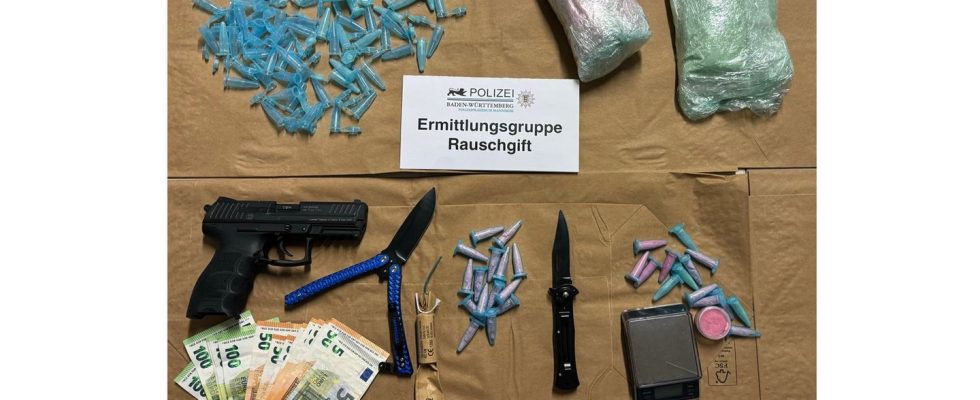“El Tusi”
Police discover new drug: That’s what’s behind the “pink cocaine”
The Mannheim police confiscated the so-called “pink cocaine” during an arrest, along with weapons, cash and drug containers
© Mannheim Police Headquarters
It’s a powder that looks downright harmless: the Mannheim police seized so-called “pink cocaine.” However, the drug has little to do with classic coke – that’s what makes it so dangerous.
Advice centers strongly warn against taking “Tusi”, as the drug is also called. For some time now, samples of “pink cocaine” have been repeatedly received at drug checking facilities. For example, the “checkit” facility in Vienna declared after examining the substance that it had nothing in common with “classic” cocaine. That’s exactly why it’s so dangerous.
“Pink cocaine” – a mix of various synthetic substances
As early as 2022, international media reported on the increasing spread of a new drug in South America. Tusi is flooding the club scenes in Venezuela, Peru, Panama, Uruguay, Costa Rica and Paraguay – a pink powder that can be mixed into drinks or snorted. What was striking even back then: “Pink Cocaine” was constantly found in different compositions. It’s not a substance, but a cocktail of drugs.
While investigations in Uruguay actually discovered cocaine in the powder alongside methamphetamine (crystal meth) and LSD, Tusi appeared in Panama as a blend of the sedative ketamine and the pharmaceutical opioid tramadol. In Venezuela, the drug became known as a mix of LSD and ecstasy. But other medications such as ibuprofen or paracetamol have also been detected in samples examined, as has caffeine.
Both the color and the name are probably intended to serve as a marketing tool for the drug. The drug advice center “checkit” explained: “The misleading names can give the impression that it is cocaine or [andere Drogen] act. Confusion with a mixture of various other substances can lead to an unpleasant intoxicating experience.” Or even be life-threatening. The drug examined in Germany and Austria consisted largely of ketamine mixed with ecstasy. A dangerous mixture, because ketamine can be particularly dangerous in combination with other substances “Downers” such as alcohol can lead to respiratory arrest, as in the case of the 14-year-old in Spain.
Flavored dye made the drug socially acceptable
Tusi is a comparatively new drug. Their worldwide spread can be attributed primarily to the pink color – and to a kind of product piracy. Because it was originally the invention of a US chemist in the 1970s. The name Tusi (or “Tusibi”) was a phonetic translation of its chemical compound “2C-B” (English: Two-CB). The new thing about the drug: It combined the euphoric effects of ecstasy with the hallucinogenic effects of LSD. For a few years, however, she was only known to insiders in the European club scene.
In the early 2000s, the substance entered Colombia in small quantities and was sold in ‘higher circles’. The reputation of the upper class drug was born – a synthetic, European drug that was significantly more expensive than the local cocaine. This had the middle and working classes in Colombia under control. But the big breakthrough didn’t materialize. For two reasons: The powder looked unappetizing with its brown color and it was painful to sniff. So a dealer came up with the idea of adding flavored pink food coloring to the substance. Consumption was now more pleasant and the aesthetics of the drug were completely different.
But compared to other intoxicants, Tusi was still complicated and expensive to produce. So dealers began cutting small amounts of 2C-B through other means. This was not noticeable to consumers because the mixtures were also colored pink. The color was considered a trademark. From this point on, only the dealer in question knew what was behind “his” girl: cocaine, ketamine, methamphetamine, LSD or ecstasy – the actual substance 2C-B, which gave the pink powder its name, has moved into the background. Only one thing has remained the same: most mixtures consist of an “Upper” and a “Downer” – known worldwide as “Speedball”. “Pink cocaine” is now said to have even replaced its white namesake as the most popular drug in South America.
Whether it’s the color, the effect or both – Tusi is now popular far beyond Latin America. With the seizure of the drug in Mannheim, it seems certain that it has also arrived in Germany.
Sources: Mannheim police press release, Insight Crime, Swissinfo, QCostarica, La Prensa, United Nations Office on Drugs, Checkit, Drugchecking.berlin

